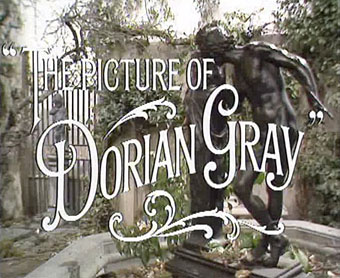
I wrote recently about John Selwyn Gilbert’s television play, Aubrey, an hour-long drama concerning the artist Aubrey Beardsley. The play was only screened once in 1982 and, like most one-off studio works of the period, is unavailable on DVD. John Osborne’s 1976 adaptation of The Picture of Dorian Gray is a welcome exception to this neglect and can be acquired in a box set along with three BBC productions of Wilde’s plays and a more recent Wilde documentary.
The stage plays are decent enough although the cast in the 1952 film version of The Importance of Being Earnest takes some beating. Dorian Gray is for me the essential work in the collection, even if its 100-minute running time cuts the story to the bone. The principal attraction in an entirely studio-bound work with few actors is the leads, and for this we have two great performances from John Gielgud as Lord Henry and Jeremy Brett as artist Basil Hallward. The tragic Dorian is played by Peter Firth who has difficulty keeping up with these heavyweights, especially in the later scenes when the story concentrates more fully on his predicament. Matters aren’t helped by his Yorkshire accent which frequently rises to the surface in a manner that would surely raise eyebrows in Mayfair drawing rooms.
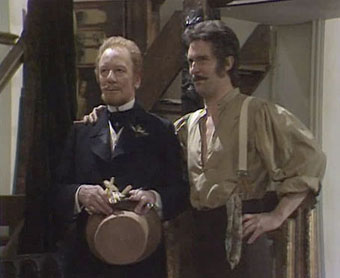
Lord Henry & Basil Hallward admire the portrait.
Lord Henry’s role in Dorian Gray must be a difficult one for an actor since most of his Lordship’s lines are Wilde’s aphorisms delivered as though they’re natural speech. Gielgud pulls this off very adeptly without seeming as though he’s memorised a book of quotations. Jeremy Brett is suitably intense as the obsessed painter in an adaptation which brings to the surface the homoerotic subtext of Wilde’s novel. Lord Henry and Basil Hallward are besotted with their young discovery while Dorian’s later relationship with Alan Campbell is presented quite obviously as a gay affair with all its potential for scandal and ruined reputation. Rumours of similar affairs dogged John Osborne, partly on account of a long friendship with gay actor Anthony Creighton. An earlier play of Osborne’s, A Patriot for Me, also concerned homosexual scandal but Osborne’s interest in these matters seems to have been purely aesthetic and intellectual.
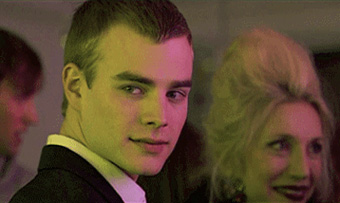
David Gallagher in Duncan Roy’s 2006 adaptation.
More recent adaptations have made the subtext fully explicit by updating the story, among them Will Self’s Dorian, an Imitation, Duncan Roy’s 2006 film (above) and Matthew Bourne’s dance version which is due to be premiered in Edinburgh next month. Such reinvention seems to miss the point in a rather fundamental way. One of the significant frissons of the novel is the way it’s a gay text without ever admitting it, and in this respect it fulfills Philip Core’s definition of camp by being “a lie which tells the truth”. When the unsaid may be stated quite openly, and all loves are free to speak their name, the tension that Wilde creates between “sin” and propriety collapses. Osborne pushes Wilde’s ambiguity as far as he can without seeming absurd or anachronistic.
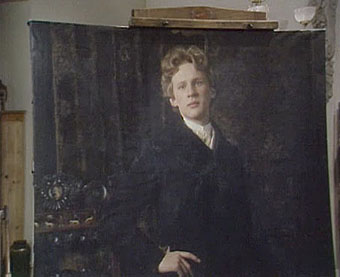
Hallward’s painting when we get to see it bears a more than passing resemblance to the portrait of artist W Graham Robertson (below) which John Singer Sargent painted in 1894. Sargent was exactly the kind of portraitist Hallward is supposed to be, as well as being included frequently in lists of gay artists. In the BBC production Peter Firth poses in the same heavy overcoat with a cane in his left hand cane as Robertson does. Robertson was 28 at the time but Sargent painted him looking at least ten years younger in what must be the definitive portrait of a fey young aesthete.
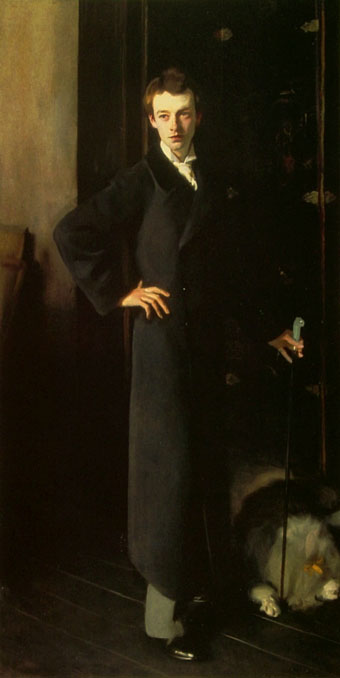
W Graham Robertson by John Singer Sargent (1894).
The corrupt condition of the portrait in the final scene doesn’t bear comparison with Ivan Albright’s chilling vision in the 1945 Hollywood version but then few paintings could. As with Aubrey, this play comes from a time when the BBC was happy to commission cheap, small-scale productions and let the actors carry the thing. The attitude today is to try and compete with the film world which means that any period production costs a small fortune and needs inflated values (lots of stars, over-emphatic music, a pandering script) in order to justify its cost with foreign sales. Jeremy Brett was fortunate to catch the tail end of this era with his role as Sherlock Holmes in the Granada TV productions. A year after Dorian Gray, Judi Bowker, who plays the doomed actress Sybil Vane, took the part of Mina Harker in the BBC’s Count Dracula. Louis Jourdan was the Count in that adaptation which, for its fidelity to the novel, still hasn’t been bettered. Count Dracula is also available on DVD which is some consolation if the corporation refuses to treat these works the way they used to. Dramas don’t need hidden portraits to fight the march of time, all they need is a new life on a silver disc.
Elsewhere on { feuilleton }
• The Oscar Wilde archive
Previously on { feuilleton }
• Aubrey by John Selwyn Gilbert
• Because Wilde’s worth it
• “The game is afoot!”

Peter Firth is a great actor and he played Dorian very well. I am glad actors had stopped using Received Pronounciation by 1976. Brett and Gielgud were both good but they were rather old for their characters.
Watched this for the first time tonight and was suitably impressed by the brilliance of the leads. What really made it for me was Gielgud making Wilde’s aphorisms fit the pattern of everyday speech. I didn’t think that was possible! His ludicrous rouge and eyebrow pencil at the end was a masterstroke, too. Jeremy Brett was an amazing Basil Hallward, definitive perhaps. Firth was good, or maybe just good enough. I’ve never been certain of what Gray should look actually like apart from having blonde hair. I rather liked the portrait at the end, although the climax seemed rushed. All in all, an absolute gem.
Hi Dave. Yes, it’s the serious tone which impressed me about Osbourne’s adaptation, there’s no attempt made to camp things up. I should watch this version again since I re-read the book after reading Neil McKenna’s Secret Life of Oscar Wilde and then re-watched the 1945 Hollywood version. Albert Lewin’s film has some great sets but apart from the Albright painting and George Sanders as Lord Henry everything is either wooden and tedious, or slanders Wilde’s intention with the introduction of superfluous females to deflect the gay subtext.
How to portray Dorian is always a fraught business since he’s set up as the most gorgeous creature ever which means that everyone will have their own concept of such an impossible ideal. Jude Law playing Bosie in the film of Wilde would have been good in the late Nineties but he’s too old for the role now. Incidentally, McKenna’s book revealed that W Graham Robertson in the above portrait was a gay friend of Wilde’s so I was closer to both the truth and the fiction than I realised in picking out that portrait.